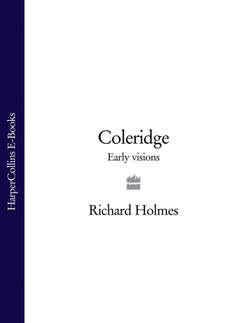Читать книгу Coleridge: Early Visions - Richard Holmes - Страница 42
9
ОглавлениеThroughout this time letters continued to fly between Cambridge and Bath (where Southey was now living with his mother), hammering out the details of Pantisocracy. Because of the emotional drama over Sara Fricker and Mary Evans (which always ended in Coleridge grimly promising to do his “Duty”), it is easy to overlook the brilliant coherence with which Coleridge developed the concepts behind the emigration scheme. He never wrote the promised treatise on Pantisocracy, but it is possible to summarise the body of ideas which emerges from the letters between October and December 1794. Several of them were to shape Coleridge’s writing for the rest of his life. Far from being an aberration, or – as is often suggested – a temporary fit of youthful idealism, they form the intellectual basis of many of the speculative questions which Coleridge carried into his major poetry and later critical prose.
Behind the broad, rather Godwinian notion of a small, self-governing community of friends (with its Quaker overtones), lay several Coleridgean ideas about the nature of man and his relations to the physical world. First was “Aspheterism”, a word coinage of memorable unpleasantness, which implied not simply the common ownership of land and stock, but the abolition of the idea of ownership itself: “non proprius”. Coleridge would later specifically deny that he intended the abolition of private property as the basis for national government, as opposed to a small community.60 But the notion that the land, and particularly the countryside, could never be “owned” in the ordinary way, that it was a common heritage belonging to all, remains in his thought. It was, so to speak, a national trust.
Second, and closely related to this, is a characteristically poetic and humorous notion of the brotherhood of man and animals, as belonging to a common nature. The Pantisocrats would befriend the natural world, and live harmoniously as part of it. This fraternal idea first appears in a splendid signing-off passage in a letter of 24 October to Francis Wrangham.
If there be any whom I deem worthy of remembrance – I am their Brother. I call even my Cat Sister in the Fraternity of universal Nature. Owls I respect & Jack Asses I love: for Alderman & Hogs, Bishops & Royston Crows, I have not particular partiality –; they are my Cousins however, at least by Courtesy. But Kings, Wolves, Tygers, Generals, Ministers, & Hyaenas, I renounce them all…May the Almighty Pantisocratizer of Souls pantisocratize the Earth, and bless you and S.T. Coleridge.61
As often with Coleridge, one of his most serious and even mystical ideas begins as a flight of extravagant fancy, a poetical joke, in which humour and imagination are inextricably entwined. Two weeks later he had developed the ideas into a deliberately provoking little poem, “Address to a Young Jack Ass”, inspired by an animal he had noticed tethered on Jesus Green, a “poor little Foal of an oppressed Race”. Here the fraternal idea is directly presented with a mixture of comic bathos and polemic defiance, with coat-trailing, “democratic” references to poverty, the “fellowship of woe”, and a “scoundrel monarch”. He daringly submitted it to the Morning Chronicle where it appeared on 9 December, the first public allusion to Pantisocracy in print:
Innocent Foal! thou poor despis’d Forlorn! –
I hail thee Brother, spite of the Fool’s Scorn!
And fain I’d take thee with me in the Dell
Of high-soul’d Pantisocracy to dwell…62
It was, of course, a gift to satirists: five years later Coleridge appeared as a braying jack-ass in a famous cartoon against the British radicals which appears in the Anti-Jacobin: and Byron would long after recall this jibe in English Bards and Scotch Renewers. Coleridge was in this sense as innocent as his foal. Yet the idea of the fraternal community in nature, the “One Life”, was to be crucial to him.
A third, shaping idea that grew out of his reflection on Pantisocracy, was the notion of the “child of Nature”. Throughout the letters he emphasises again and again to Southey the need to bring up children outside the old, transmitted “prejudications” of corrupt society.63 Thoughtless fathers, uneducated mothers, and even older schoolfellows, could unwittingly pass on the “Fear and Selfishness” which warps the infant mind in an unreformed state of civilisation. Even religious doctrines could be dangerous – “How can we ensure their silence concerning God etc?” – when these were not allowed to develop naturally and directly from personal reverence for the creation. It was nature herself who must be the great teacher, and the essential role of education – and by extension, poetry and philosophy itself – must be as an affectionate interpreter of man’s place in the natural world. In the countryside the images of divine beauty and goodness “are miniatured on the mind of the beholder, as a Landscape on a Convex Mirror”.64
